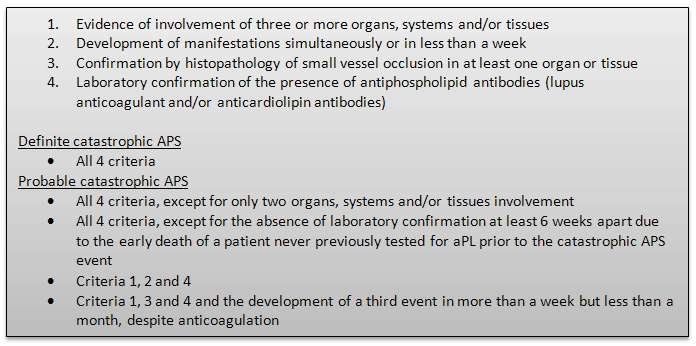Final Diagnosis -- Probable antiphospholipid antibody syndrome
FINAL DIAGNOSIS
Probable catastrophic antiphospholipid antibody syndrome.
DISCUSSION
The antiphospholipid syndrome (APS) is defined as vascular thrombosis and/or pregnancy morbidity occurring in persistently antiphospholipid antibody (aPL)-positive patients (1, 2). The most recent diagnostic criteria for APS are as follows (2):
Table 4: Updated Sapporo classification criteria for antiphospholipid syndrome (APS)

Catastrophic APS is the most severe form of APS characterized by the following features (3):
- Clinical evidence of multiple organ involvement over a short period of time.
- Histopathologic evidence of small vessel involvement.
- Laboratory confirmation of aPL
Table 5: Preliminary criteria for diagnosis of catastrophic APS (1,4):

Presence of lupus anticoagulant in this patient was based on a panel of positive coagulation tests in this patient; 1) prolonged PTT which did not correct on mixing studies, 2) positive Hexagonal lipid test and 3) increased dRVVT ratio. Based on the overall clinical and laboratory findings, the criteria for definite APS were met.
As for the diagnosis of catastrophic APS, three of the 4 criteria were documented;
- There was evidence of involvement of more than 3 organs.
- There was histologic confirmation of small vessel occlusion in more than one organ.
- There was laboratory confirmation of presence of antiphospholipid antibody.
Since the development of thrombotic events spanned more than a period of 1 week but less than one month, the fourth criterion could not be fulfilled and hence the diagnosis of probable catastrophic APS was made.
Catastrophic APS can mimic other disease entities and hence should be considered in the list of differential diagnoses (1).
- Acute thrombotic microangiopathy with or without red cell fragmentation encompasses a long list of differential diagnoses and many of these have overlapping clinical features. Catastrophic APS is a type of acute thrombotic microangiopathy and may or may not present with thrombocytopenia. It might closely mimic disseminated intravascular coagulation (DIC). Catastrophic APS with thrombocytopenia has higher incidence of DIC, elevated FDPs and intravascular hemolysis.
- Sepsis and severe sepsis can be associated with DIC, thrombocytopenia, bleeding and microthrombosis. These findings are also seen in catastrophic APS. Both these entities converge to a final common pathway of multi organ failure. In this case there was no evidence of infection to account for the vascular manifestations.
- Heparin-induced thrombocytopenia (HIT) usually occurs within 4 to 10 days of heparin treatment. The severe form (Type II) is an immunemediated disorder characterized by the formation of antibodies against the heparin-platelet factor 4 (PF4) complex. Diagnosis is based on detection of anti-heparin-PF4 antibodies. However, antiheparin- PF4 antibodies could also be found in heparin-na´ve aPL-positive patients. These antibodies can result in diagnostic difficulties in heparin receiving aPL-positive patients with thrombocytopenia and multiple organ thrombosis. In our case, test for this antibody was negative.
Acute thrombotic microangiopathy, sepsis and HIT can mimic catastrophic APS. Catastrophic APS is an uncommon manifestation of an uncommon disease representing 1% of APS (5) and the clinical manifestations can be relatively non-specific. For all these reasons, the diagnosis can be delayed. Catastrophic APS is life-threatening with a mortality rate of approximately 50% (5). The mainstay of treatment is a combination of anticoagulation (heparin followed by replacement with warfarin) and corticosteroids. In immediately life threatening situations, intravenous immunoglobulin or plasmapheresis is recommended in addition to the standard treatment regimen (5). A high level of suspicion for catastrophic APS is important as early treatment can be lifesaving.
REFERENCES
- Erkan D, Espinosa G, Cervera R. Catastrophic antiphospholipid syndrome: Updated diagnostic algorithms. Autoimmun Rev. 2010;10:74-9.
- Miyakis S, Lockshin MD, Atsumi T, et al. International consensus statement on an update of the classification criteria for definite antiphospholipid syndrome (APS). J Thromb Haemost 2006;4(2):295-306.
- Erkan D, Cervera R, Asherson RA. Catastrophic antiphospholipid syndrome: where do we stand? Arthritis Rheum 2003;48(12):3320-7.
- Asherson RA, Cervera R, de Groot PG, et al. Catastrophic antiphospholipid syndrome: international consensus statement on classification criteria and treatment guidelines. Lupus 2003;12(7):530-4.
- Bucciarelli S, Erkan D, Espinosa G, et al. Catastrophic antiphospholipid syndrome: treatment, prognosis, and the risk of relapse. Clin Rev Allergy Immunol. 2009;36(2-3):80-4.
 Contributed by Somak Roy, MD, Franklin A. Bontempo, MD, Larry Nichols, MD.
Contributed by Somak Roy, MD, Franklin A. Bontempo, MD, Larry Nichols, MD.







![]() Contributed by Somak Roy, MD, Franklin A. Bontempo, MD, Larry Nichols, MD.
Contributed by Somak Roy, MD, Franklin A. Bontempo, MD, Larry Nichols, MD.